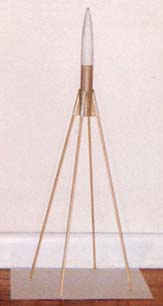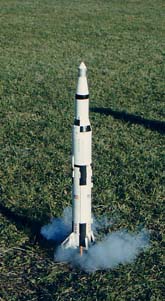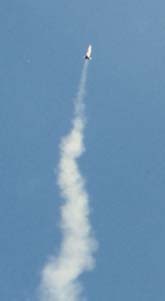
a website for
those who got back into model rocketry as adults
BORN
AGAIN ROCKETEER
home
no launch pad
 When
I was a kid, I was always a minimalist when it came to launch equipment.
I designed a number of compact launch pads with built-in storage space
so it wasn't necessary to carry a separate range box. Inevitably I started
to wonder if I could build a rocket that wouldn't need a launch pad at
all. I thought that if the rocket nozzle were located above the rocket
center of gravity, the rocket would always want to fly straight up. My
first padless rocket was Starfire, shown here. It flew great without a
launch pad, and I soon built a D-powered version of this design. To keep
the balance point behind the nozzle, I used a short body tube, with the
parachute stored inside the nose cone.
When
I was a kid, I was always a minimalist when it came to launch equipment.
I designed a number of compact launch pads with built-in storage space
so it wasn't necessary to carry a separate range box. Inevitably I started
to wonder if I could build a rocket that wouldn't need a launch pad at
all. I thought that if the rocket nozzle were located above the rocket
center of gravity, the rocket would always want to fly straight up. My
first padless rocket was Starfire, shown here. It flew great without a
launch pad, and I soon built a D-powered version of this design. To keep
the balance point behind the nozzle, I used a short body tube, with the
parachute stored inside the nose cone.
Next I tried an Estes Marauder with fins modified for spin stabilization. That one flew great too, despite the fact that spin stabilization doesn't go into effect until the rocket is already well off the ground. I concluded that the moment of inertia of these rockets had been sufficient to ensure a straight launch.
This concept was supported by further testing, always with appropriate safety measures. I found that moderate to large size rockets invariably launched straight up, while small BT-20 size rockets tended to launch up to 30 degrees off from vertical. Very long rockets should give the straightest launch, but there is a danger of the rocket tipping over if it is too long, in relation to the span of the fins.
My padless rocketry activities culminated with the launch of my Estes Saturn V rocket. There was some risk of it blowing over before or during launch, because it doesn't have adequate fins. However, it has plenty of inertia to protect it from other launchtime disturbances. It took off nice and straight and had a beautiful flight!
Here are some guidelines for those wishing to try padless rocketry:
- Take appropriate safety precautions.You are solely responsible for any resultant injury or damage.
- Never use igniter plugs or protrusive engine hooks. These inventions were introduced after the tests described above, and they may impart forces during launch that would prevent a vertical flight.
- Install the igniter by pressing a small ball of recovery wadding into the nozzle. Do not use tape.You may wish to remove the paper supports from the igniter after installing it.
- Make sure the nozzle isn't chipped.
- Rockets should weigh at least 2 ounces and should be at least 12 inches long.
- Fins should be swept back enough to provide good ground clearance, and should have a wide enough span to ensure stability on the ground.
- Always launch from a smooth, fireproof surface, away from flammable materials.
- Ensure that the ignition wires or other objects cannot catch on fins or otherwise interfere with the launch.
Of course, if you can fly a rocket without a launch pad, you can also fly a launch pad without a rocket. I never took any photos of my Porta-Pad conversion, but it was one of my favorite rockets. I've recently re-created it, and soon I'll be posting some pictures and videos, once the model is flown!

